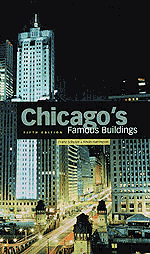
“This is the one book on Chicago architecture that everyone should have.”—Chicago Tribune
![]()
More excerpts:
Harold Washington Library Center
Elsewhere on the web:
Page for the Chicago Cultural Center from the Chicago Commission on Landmarks.
Official city website for the Chicago Cultural Center
Chicago Cultural Center
from
Chicago's Famous Buildings: Fifth Edition
by Franz Schulze and Kevin Harrington
[9]
Chicago Cultural Center (1897)
(Originally the Chicago Public Library)
78 East Washington Street
Architects: Shepley, Rutan & Coolidge (1897); restoration, Holabird & Root (1977)
 Chicago had long needed an adequate central public library when Shepley, Rutan & Coolidge won the commission for this building. As the successor firm of the late H. H. Richardson (whose Glessner House [123] is his only surviving Chicago building), they participated in the 1893 World’s Columbian Exposition. Their Art Institute of Chicago had already shown their skills in large, complex, and symbolic public projects. Sited on a small public square facing east across Michigan Avenue to rail yards, one entered the library at its narrow north or south ends. At Washington Street, to the south, one entered between Ionic columns into a vestibule dominated by a grand stairway of Carrara marble inlaid with mosaics. At the top of these stairs is the present Preston Bradley Hall, crowned by a Tiffany dome. Words and images enliven the surfaces of these spaces, celebrating language, literature, and the book. The many languages of the texts acknowledge the multiethnicity of Chicago’s people. One text notes the sweetness of finding, in a foreign land, works in one’s mother tongue.
Chicago had long needed an adequate central public library when Shepley, Rutan & Coolidge won the commission for this building. As the successor firm of the late H. H. Richardson (whose Glessner House [123] is his only surviving Chicago building), they participated in the 1893 World’s Columbian Exposition. Their Art Institute of Chicago had already shown their skills in large, complex, and symbolic public projects. Sited on a small public square facing east across Michigan Avenue to rail yards, one entered the library at its narrow north or south ends. At Washington Street, to the south, one entered between Ionic columns into a vestibule dominated by a grand stairway of Carrara marble inlaid with mosaics. At the top of these stairs is the present Preston Bradley Hall, crowned by a Tiffany dome. Words and images enliven the surfaces of these spaces, celebrating language, literature, and the book. The many languages of the texts acknowledge the multiethnicity of Chicago’s people. One text notes the sweetness of finding, in a foreign land, works in one’s mother tongue.
The north entrance on Randolph Street uses the Doric order, associated with the military, to lead into the spaces of the Grand Army of the Republic. The GAR was the association of Union veterans of the Civil War. Its grand staircase leads first to a large room, the GAR Rotunda, dominated by another stained-glass dome, this time by Healy & Millet. Beyond is Memorial Hall, where the campaigns of the war are inscribed. Lincoln and Grant are only the best known of Illinoisans who served the nation at the time.
As Chicago’s population rocketed from 1 million in 1890 to more than 3 million in 1930, the library was soon inadequate to the demands placed on it. In 1974 the library began its move to temporary quarters in anticipation of a new central facility, which was completed in 1991. Holabird & Root completed their conversion and restoration of the building in 1977. The open U-shaped court on its west side was enclosed with accessible ramps and other services. Renamed the Chicago Cultural Center, the building has a rich and eclectic mix of uses including galleries, performance, lecture, and film spaces, visitor’s and senior citizen’s centers, a café, a Museum of Broadcast Communication, and offices for the city’s Department of Cultural Affairs.
Copyright notice: ©2003 Excerpted from pages 38-40 of Chicago's Famous Buildings: 5th edition by Franz Schulze and Kevin Harrington, published by the University of Chicago Press. ©2003 by the University of Chicago. All rights reserved. This text may be used and shared in accordance with the fair-use provisions of U.S. copyright law, and it may be archived and redistributed in electronic form, provided that this entire notice, including copyright information, is carried and provided that the University of Chicago Press is notified and no fee is charged for access. Archiving, redistribution, or republication of this text on other terms, in any medium, requires the consent of University of Chicago Press.
Franz Schulze and Kevin Harrington
Chicago's Famous Buildings: Fifth edition
©1965, 1969, 1980, 1993, 2003; 358 pages, 206 halftones; 4-3/4 x 8
Cloth $35.00 ISBN: 0-226-74064-1
Paper $14.00 ISBN: 0-226-74066-8For information on purchasing the book—from bookstores or here online—please go to the webpage for Chicago's Famous Buildings.
See also:
- Our catalog of books about Chicago.
- Our catalog of architecture titles.
- Other excerpts and online essays from University of Chicago Press titles.
- Sign up for e-mail notification of new books in this and other subjects.